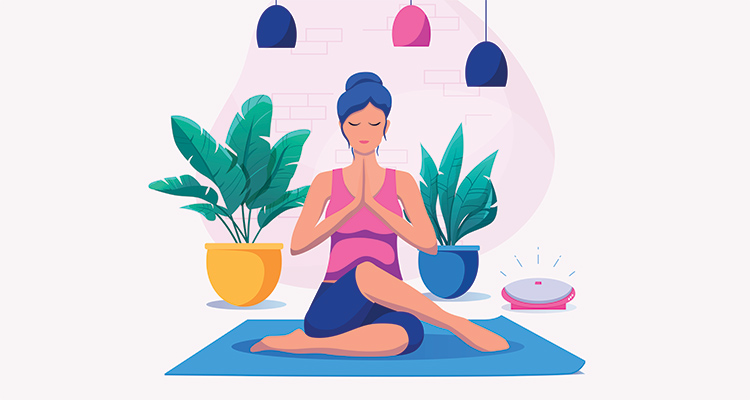SSS Team, SSSPORTS.COM

In a world of demanding work schedules and mindless scrolling, taking time to quiet the mind has become even more important. With mental health awareness now a regular topic of conversation, meditation has become a sort after practice to focus the mind, develop awareness, and achieve clarity and calm.
Starting a meditation practice can seem daunting. In the beginning, it’s normal for thoughts to race, and to feel like it isn’t working. But the key to
meditation is discipline, and being kind to yourself. Think of it the same way
you would as working out at the gym or going for a run — the more you exercise
the parts of your brain that help you focus and concentrate, the stronger it
will become.
Mindfulness meditation improves mental clarity by training the brain to focus on the present moment, reducing distractions, and enhancing cognitive function. Regular practice decreases mental clutter by calming the mind, leading to better decision-making and problem-solving. This practice can also reduce anxiety and stress through guided meditation and mindfulness techniques, creating space for clearer thinking and emotional regulation.
The advantages of meditation, such as improved attention span and reduced overthinking, stem from its ability to increase gray matter density in brain areas responsible for focus and memory. Additionally, meditation benefits extend to aiding sleep, which further boosts mental clarity by allowing the brain to recover and recharge effectively.

Meditation is widely recognized for its incredible benefits, including reducing stress and anxiety, improving sleep and concentration, and increasing overall happiness. A great way to start meditation is via guided meditation, i.e. through a class or an app. For a beginner, a teacher or expert guidance would be a great way to help get the most out of this new experience.
With different types of meditation techniques to choose from, finding one that works for you is key. Here are few meditation techniques to try:

As the name suggests, you focus your attention on a mantra – a word, phrase, or syllable, and repeat it out aloud. The intention here is that the subtle vibrations from repetitions will encourage a positive change, helping you move into a deeper state of meditation. This practice is great for those who don’t like silence and enjoy repetition.

This form of meditation urges us to remain aware and present in the moment. It trains us to move from thinking to sensing. Rather than dwelling on the past or dreading the future, this meditation encourages us to become aware of our immediate surroundings or experiences. It urges us not to get attached to our thoughts but rather just allow them to be. The advantage of mindfulness meditation is that it can be practiced anywhere. This form of meditation is known to improve focus and memory while reducing fixation on negative emotions or thoughts.

Just as there are many different types of meditation, there are many styles of yoga. Some types, such as Kundalini, focuses on using meditative techniques to strengthen and relax the nervous system. Kundalini Yoga is the yoga of deep awareness and transformation. It helps build strength and resilience by incorporating movement, dynamic breathing techniques, meditation, and chanting mantras. Best performed under the guidance of a teacher, consider Kundalini if you want to craft a better life and healthier habits.

Sound meditation is a form of focused awareness type of meditation. This ancient form which has risen in popularity in recent times, uses bowls, gongs, and other instruments to create sound vibrations that help focus the mind and bring it into a more relaxed state. A study has shown that an hour-long of sound meditation can help reduce tension, anger, fatigue and depression. If gongs and bowls aren’t your thing, try sounds of nature or ambient sounds like white noise to help you relax and unwind.

Also known as body scan meditation, progressive relaxation is a practice aimed at reducing tension in the body and promoting relaxation. The goal is to identify tension and release it. Oftentimes, this form of meditation requires you to tense and then relax muscles throughout the body.
To help with this technique, some are encouraged to imagine a gentle wave flowing through your body to help release any tension. This form of meditation, best performed before bedtime, may help reduce chronic pain and promotes calmness.
Yes, meditation can significantly help reduce anxiety. Mindfulness meditation is particularly effective as it trains the mind to focus on the present moment, reducing overthinking and fear about the future, which are common triggers for anxiety. This practice promotes relaxation by lowering cortisol levels, the stress hormone, and activating the parasympathetic nervous system, which calms the body.
Guided meditation and mindfulness techniques offer tools to reframe anxious thoughts, making them less overwhelming. Consistent practice provides long-term benefits, improving emotional regulation and resilience. Moreover, the advantages of meditation extend to better sleep, which is crucial for managing anxiety. Regular sessions of anxiety meditation can therefore lead to a more balanced and peaceful state of mind.
Any meditation is better than no meditation. Start with 5 to 10 minutes a day, and grow from there. Alternatively, you could start with a few sessions a week.
Choose a meditation technique that works for you, and meditate at the same time each day to build a healthy daily habit. Don’t be afraid to step out of your comfort zone and try different types. It often takes a little trial and error until you find the one that suits you.
Whether you’re looking to reduce stress or find stillness, there definitely is a meditation practice that is for you.
Share your favorite meditation techniques with us on Instagram @sunsandsports and discover the best yoga and relaxation outfits by visiting our website, Sun & Sand Sports.
Subscribe below to our newsletter and download our app on the App Store or Google Play for the latest updates.
*We recommend checking with your doctor before beginning any exercise or yoga routine.